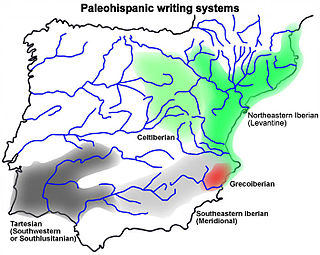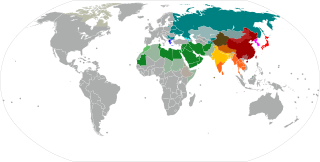Iberian semi-syllabaries
The Paleohispanic semi-syllabaries are a family of scripts developed in the Iberian Peninsula at least from the 5th century BCE – possibly from the 7th century. Some researchers conclude that their origin lies solely with the Phoenician alphabet, while others believe the Greek alphabet also had a role. Paleohispanic semi-syllabaries are typologically unusual because their syllabic and alphabetic components are equilibrated: they behave as a syllabary for the stop consonants and as an alphabet for other consonants and vowels. In the syllabic portions of the scripts, each stop-consonant sign stood for a different combination of consonant and vowel, so that the written form of ga displayed no resemblance to ge. In addition, the southern original format did not distinguish voicing in these stops, so that ga stood for both /ga/ and /ka/, but one variant of the northeastern Iberian script, the older one according to the archaeological contexts, distinguished voicing in the stop consonants by adding a stroke to the glyphs for the alveolar (/d/~/t/) and velar (/g/~/k/) syllables.
The Tartessian or Southwestern script had a special behaviour: although the letter used to write a stop consonant was determined by the following vowel, the following vowel was also written. Some scholars treat Tartessian as a redundant semi-syllabary, others treat it as a redundant alphabet. Notably, Etruscan and early Latin did something similar with C, K, and Q, using K before a, Q before o and u, and C elsewhere, for both /k/ and /g/.
Other semi-syllabaries
Other scripts combine attributes of alphabet and syllabary. One of these is bopomofo (or zhuyin), a phonetic script devised for transcribing certain varieties of Chinese. Bopomofo includes several systems, such as Mandarin Phonetic Symbols for Mandarin Chinese, Taiwanese Phonetic Symbols for Taiwanese Hokkien and Hakka, and Suzhou Phonetic Symbols for Wu Chinese. Bopomofo is not divided into consonants and vowels, but into onsets and rimes. Initial consonants and "medials" are alphabetic, but the nucleus and coda are combined as in syllabaries. That is, a syllable like kan is written k-an, and kwan is written k-u-an; the vowel is not written distinct from a final consonant. Pahawh Hmong is somewhat similar, but the rime is written before the initial; there are two letters for each rime, depending on which tone diacritic is used; and the rime /āu/ and the initial /k/ are not written except in disambiguation.
Old Persian cuneiform was somewhat similar to the Tartessian script, in that some consonant letters were unique to a particular vowel, some were partially conflated, and some simple consonants, but all vowels were written regardless of whether or not they were redundant.
The practice of plene writing in Hittite cuneiform resembles the Old Persian situation somewhat and may be interpreted such that Hittite cuneiform was already evolving towards a quasi-alphabetic direction as well.
The modern Bamum script is essentially CV-syllabic, but does not have enough glyphs for all the CV syllables of the language. The rest are written by combining CV and V glyphs, making these effectively alphabetic.
The Japanese kana syllabary occasionally acts as a semi-syllabary, for example when spelling syllables that do not exist in the standard set, like トゥ, tu, or ヴァ, va. In such cases, the first character functions as the consonant and the second as the vowel.

An alphabet is a standard set of letters written to represent particular sounds in a spoken language. Specifically, letters correspond to phonemes, the categories of sounds that can distinguish one word from another in a given language. Not all writing systems represent language in this way: a syllabary assigns symbols to spoken syllables, while logographies assign symbols to words, morphemes, or other semantic units.
An abjad, also abgad, is a writing system in which only consonants are represented, leaving vowel sounds to be inferred by the reader. This contrasts with alphabets, which provide graphemes for both consonants and vowels. The term was introduced in 1990 by Peter T. Daniels. Other terms for the same concept include partial phonemic script, segmentally linear defective phonographic script, consonantary, consonant writing, and consonantal alphabet.

An abugida – sometimes also called alphasyllabary, neosyllabary, or pseudo-alphabet – is a segmental writing system in which consonant–vowel sequences are written as units; each unit is based on a consonant letter, and vowel notation is secondary, similar to a diacritical mark. This contrasts with a full alphabet, in which vowels have status equal to consonants, and with an abjad, in which vowel marking is absent, partial, or optional – in less formal contexts, all three types of the script may be termed "alphabets". The terms also contrast them with a syllabary, in which a single symbol denotes the combination of one consonant and one vowel.
In the linguistic study of written languages, a syllabary is a set of written symbols that represent the syllables or moras which make up words.
The Phoenician alphabet is a consonantal alphabet used across the Mediterranean civilization of Phoenicia for most of the 1st millennium BCE. It was the first mature alphabet, and attested in Canaanite and Aramaic inscriptions found across the Mediterranean region. In the history of writing systems, the Phoenician script also marked the first to have a fixed writing direction—while previous systems were multi-directional, Phoenician was written horizontally, from right to left. It developed directly from the Proto-Sinaitic script used during the Late Bronze Age, which was derived in turn from Egyptian hieroglyphs.

The Ugaritic writing system is a Cuneiform Abjad with syllabic elements used from around either 1400 BCE or 1300 BCE for Ugaritic, an extinct Northwest Semitic language, and discovered in Ugarit, Syria, in 1928. It has 30 letters. Other languages were occasionally written in the Ugaritic script in the area around Ugarit, although not elsewhere.

The Iberian scripts are the Paleohispanic scripts that were used to represent the extinct Iberian language. Most of them are typologically unusual in that they are semi-syllabic rather than purely alphabetic. The oldest Iberian inscriptions date to the 4th or possibly the 5th century BCE, and the latest from end of the 1st century BCE or possibly the beginning of the 1st century CE.

The Celtiberian script is a Paleohispanic script that was the main writing system of the Celtiberian language, an extinct Continental Celtic language, which was also occasionally written using the Latin alphabet. This script is a direct adaptation of the northeastern Iberian script, the most frequently used of the Iberian scripts.

Tartessian is an extinct Paleo-Hispanic language found in the Southwestern inscriptions of the Iberian Peninsula, mainly located in the south of Portugal, and the southwest of Spain. There are 95 such inscriptions, the longest having 82 readable signs. Around one third of them were found in Early Iron Age necropolises or other Iron Age burial sites associated with rich complex burials. It is usual to date them to the 7th century BC and to consider the southwestern script to be the most ancient Paleo-Hispanic script, with characters most closely resembling specific Phoenician letter forms found in inscriptions dated to c. 825 BC. Five of the inscriptions occur on stelae that have been interpreted as Late Bronze Age carved warrior gear from the Urnfield culture.
Elamite cuneiform was a logo-syllabic script used to write the Elamite language. The corpus of Elamite cuneiform consists of tablets and fragments. The majority were created during the Achaemenid era, and contain primarily economic records.
Great Lakes Algonquian syllabics is a writing system for several Algonquian languages that emerged during the nineteenth century and whose existence was first noted in 1880. It was originally used near the Great Lakes: Fox, Sac, and Kickapoo, in addition to Potawatomi. Use of the script was subsequently extended to the Siouan language Ho-Chunk. Use of the Great Lakes script has also been attributed to speakers of the Ottawa dialect of the Ojibwe language, but supporting evidence is weak.

Ojibwe is an indigenous language of North America from the Algonquian language family. Ojibwe is one of the largest Native American languages north of Mexico in terms of number of speakers and is characterized by a series of dialects, some of which differ significantly. The dialects of Ojibwe are spoken in Canada from southwestern Quebec, through Ontario, Manitoba and parts of Saskatchewan, with outlying communities in Alberta and British Columbia, and in the United States from Michigan through Wisconsin and Minnesota, with a number of communities in North Dakota and Montana, as well as migrant groups in Kansas and Oklahoma.

The Southwest Script or Southwestern Script, also known as Tartessian, South Lusitanian and Conii script is a Paleohispanic script used to write an unknown language usually identified as Tartessian. Southwest inscriptions have been found mainly in the southwestern quadrant of the Iberian Peninsula, mostly in the south of Portugal, but also in Spain.

The Paleohispanic scripts are the writing systems created in the Iberian Peninsula before the Latin alphabet became the main script. Most of them are unusual in that they are semi-syllabic rather than purely alphabetic, despite having supposedly developed, in part, from the Phoenician alphabet.

The northeastern Iberian script, also known as Levantine Iberian or Iberian, was a member of the epigraphic family of paleohispanic scripts located roughly in eastern Spain, concentrated in the northeast, and in Aquitaine of southern France. The script is a type of writing, or graphemic representation, not a type of language. Linguistics does not apply except only incidentally.

The southeastern Iberian script, also known as Meridional Iberian, was one of the means of written expression of the Iberian language, which was written mainly in the northeastern Iberian script and residually by the Greco-Iberian alphabet. About the relation between northeastern Iberian and southeastern Iberian scripts, it is necessary to point out that they are two different scripts with different values for the same signs; however it is clear that they had a common origin and the most accepted hypothesis is that northeastern Iberian script derives from southeastern Iberian script. In fact, the southeastern Iberian script is very similar, both considering the shape of the signs or their values, to the Southwestern script used to represent an unknown language usually named Tartessian. The main difference is that southeastern Iberian script does not show the vocalic redundancy of the syllabic signs. Unlike the northeastern Iberian script the decipherment of the southeastern Iberian script is not yet complete, because there are a significant number of signs on which scholars have not yet reached a consensus. Although it is believed that the southeastern Iberian script does not show any system to differentiate between voiced and unvoiced occlusives, unlike the northeastern Iberian script, a recent paper defends the existence of a dual system also in the southeastern Iberian script.

The Greco-Iberian alphabet is a direct adaptation of an Ionic variant of a Greek alphabet to the specifics of the Iberian language, thus this script is an alphabet and lacks the distinctive characteristic of the paleohispanic scripts that present signs with syllabic value, for the occlusives and signs with monophonemic value for the rest of consonants and vowels.

The different varieties of Chinese have been transcribed into many other writing systems.

A writing system comprises a particular set of symbols, called a script, as well as the rules by which the script represents a particular language. Writing systems can generally be classified according to how symbols function according to these rules, with the most common types being alphabets, syllabaries, and logographies. Alphabets use symbols called letters that correspond to spoken phonemes. Abjads generally only have letters for consonants, while pure alphabets have letters for both consonants and vowels. Abugidas use characters that correspond to consonant–vowel pairs. Syllabaries use symbols called syllabograms to represent syllables or moras. Logographies use characters that represent semantic units, such as words or morphemes.









